Above: Sister and brother Marian and James Tingley stand on the maple tree that came down during the Hurricane of ’38, with the family home in the background. Submitted photo
The devastating storm took place 85 years ago this week
By Laura Sullivan
As the summer of 1938 faded into September, things were busy at the Tingley homestead on Peirce Street. James Tingley, Jr., was starting his first semester at R.I. State (now URI), having graduated from the East Greenwich Academy the previous June. His younger sister, Marian, had received her 9th grade diploma from James H. Eldredge School, also the previous June, and was starting her first days at the East Greenwich Academy, just up the street.
Meanwhile, at the house, renovations were underway to update the kitchen and pantries, mostly unchanged from their original 1894 construction, which featured wainscoting on the walls, wooden floors, a kerosene/coal stove and a modest sink, augmenting another setup the floor below, in the basement. The family of five (including Grandpa Benson) ate around a modest drop-leaf table in the kitchen, a relic from the Benson family farm. After each meal, Marian – my mother – would be tasked with folding the tablecloth and storing it on a corner shelf, beneath the Benson clock, once the dishes had been cleared. With the financial heartaches and challenges of the Great Depression on the wane, and some new professional opportunities for the main breadwinner of the house, it was time for an upgrade.
Once the demolition began in the kitchen, there were many decisions to be made: The installation of a pull-chain ventilation fan over the stove, an opening in the floor within a cabinet that provided a laundry chute to the basement, and that beautiful farmhouse-style kitchen sink, in pale yellow, placed in the main pantry for upstairs meal preparations, with a window view to the back yard. The wainscoting in the kitchen would be replaced by pale yellow tile on the walls, matching the kitchen sink, with black headings, in the style of the day, and the wooden floors would be covered with linoleum. Oh my. Marie’s T.G.T.B.T. Club girls would surely be envious of these upgrades to her kitchen. (The T.G.T.B.T. acronym was a well-kept secret of this longtime group of about 10 women – many of them bridesmaids at Marie’s wedding to James Tingley, Sr., in 1916, and will stay secret for now!).
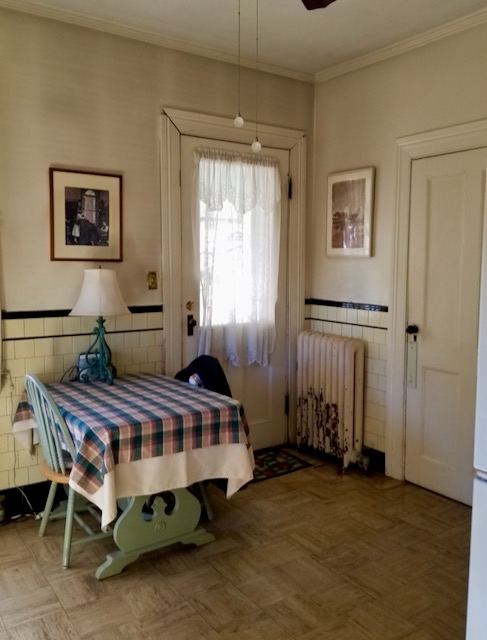
The Tingley/Sullivan kitchen in 2020, with the wall tiling, linoleum floor … and the green kitchen table, all from the renovation of 1938. Submitted photo
Among the decisions and acquisitions was the purchase of a dining set for the kitchen, to replace that faithful drop-leaf table and assorted chairs. The choice was a wooden, trestle-ended table, in somewhat of an Art-Deco style, equipped with an insert that extended the seating from four to six: two on each side, and one on each end. The insert could be lowered below the table, thus enabling the two halves to slide together for seating for two, or four, with one on each end. The table was finished in a celery-green shade, with narrow gold trim. Four chairs came with the set, in the same celery green shade and gold trim, with dark green cushioned seats.
On the morning of Wednesday, Sept. 21, Marian headed up the street to school, James Jr. drove off to classes in Kingston, and James Sr. left for Providence. Though the day started off sunny, weather conditions quickly deteriorated, as the skies darkened and the winds picked up. With no sophisticated forecasting to provide information, warnings and preparations, everyone was caught off-guard. Marie – my grandmother – called the telephone company to inform them of telephone poles swaying dangerously in the wind outside. “Ma’am,” the operator said, “they’re swaying everywhere!”
Classes were dismissed at the East Greenwich Academy and James Jr. came home from Kingston. James Sr. – my grandfather – left his office on lower Westminster Street, escaping before the city flooded, and making his way home by dodging falling trees and telephone poles, and driving across fields where the roads were impassable. Up on the hill, flooding and a storm surge were not immediate dangers, but the family watched from inside the house as debris blew in the winds, and the large maple in the rear of the yard toppled over. With the kitchen in the midst of the renovation work, the drafts from outside swirled dust everywhere throughout the house.
That day, what became known in Rhode Island history and legend as the Great Hurricane of 1938, created devastation, loss of life and experiences translated to memories decades hence. From its birth earlier in the month, off the coast of Africa, to its journey across the Atlantic, the hurricane was nourished by the warm ocean waters, approaching a Category 5 status as it neared the Caribbean and eyed the Southeast coast of the United States. Though it originally seemed to threaten the Miami area, the limited mapping and communications resources of the day noted the storm’s path turning to the Northeast, likely heading out to the open waters of the Atlantic. Further tracking failed to note the storm’s sudden turn towards New England. By the time of its arrival on Long Island on the morning of Sept. 21, it was too late to sound the alert.
From its landfall on the eastern end of Long Island, the whirling monster crossed the Sound and barreled up the Connecticut River Valley – a Category 3 hurricane. Rhode Island took the worst hit, as 262 people lost their lives. The winds and waters ravished the land and shoreline, sending a storm surge up the Bay, fueled by the full moon high tide at the autumnal equinox. The resulting devastation left the state in shambles, with 2,000 houses and 899 boats destroyed, and sections of the shoreline permanently altered.
Here in East Greenwich, there were no reports of lives lost in the storm, but the damage was just as excessive as elsewhere. Countless trees, including many stately elms, blocked streets, or toppled onto houses. Scalloptown’s shanties and residences were wiped out, along with boats, essential to the fishing industry. Farms on the outskirts suffered as well, losing buildings and livestock. Headquarters for those left homeless were set up at the Varnum Armory and the fire station on Main Street. With its offices on London Street flooded, the Rhode Island Pendulum used the presses at the Pawtuxet Valley Times to publish the next day’s Special Edition. King Gorman, the “Scallop King,” placed a large ad in this issue, declaring, “Washed Out – But Not Blown Out: And the Kingfish Roars On.” Similar ads, stating specials and a can-do attitude, ran from Izzi’s Grocery on Duke Street, and H. Fogel & Son, Gus Zenga’s and Bergstrom’s Market – all on Main Street. Likewise, the Providence Journal, flooded out of the Capital City, printed its Thursday edition on the presses of The Boston Post.
Work in town resumed quickly to restore services and clean up. Rhode Island Governor Robert Quinn pushed back the end of Daylight Saving Time a week, from Sept. 25 to Oct. 2, in order to provide more daylight for the cleanup efforts. Electricity came back on about a week later, starting along Main Street, and then extending to the outskirts. Phone service followed, so residents could be in touch with worried friends and relatives out of the area, who heard or read of the disaster that had befallen Rhode Island. Letters came to the house from Marie’s siblings in Concord, N.H., and Weymouth, Mass., also impacted by the hurricane. Each asked if the iconic birch tree in the yard here had survived (it had). Even James’s relatives in Cape Breton, Nova Scotia, wrote to express concern.
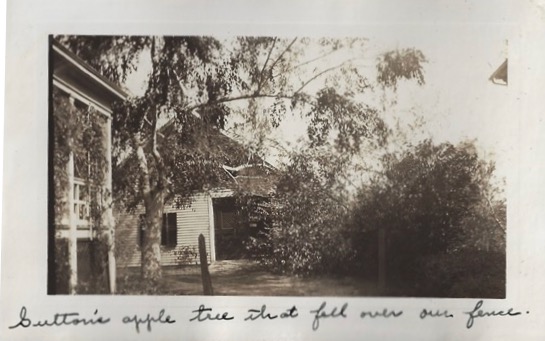
A view of the Tingley house from Peirce Street – the beloved birch tree survived the ’38 hurricane but a neighbor’s apple tree did not. Submitted photo
Once things were relatively put back together and a sense of normalcy returned, work resumed in the kitchen, as the walls, floor, and countertops were installed, and that kitchen table with its four chairs was set up. Marie had her new kitchen.

Tucker on the laptop in 2020. Submitted photo
Over the following decades, the table has been a constant, seating family and friends for thousands of meals, cups of coffee and home-baked treats – a center of gathering, conversations, celebrations, confidences and confessionals. And cats. At some point a hot pot was placed on the table, resulting in a scorched wound that needed a concealing tablecloth. Marie’s oversight of her kitchen ended in 1961, followed by years of occasional occupancy, and then several years of vacancy, until her granddaughter moved in with her college roommate, following their 1975 graduation. Once again, the kitchen table was alive with meals and activity – a new generation.
The table and chairs generally weathered the use, but grew a little worn, creaky and wobbly. On a first dinner date at the house, a pot roast dinner was served to Michael, who was gracious enough not to mention that the meat required some effort to slice, causing the table to wobble. Over the course of time, Michael became the co-occupant of the house, as he married this writer, and eventually painted the table, repairing the scorch mark, and stabilizing the wobble. The four chairs, also wobbly, were also painted but later replaced with study Windsor chairs.
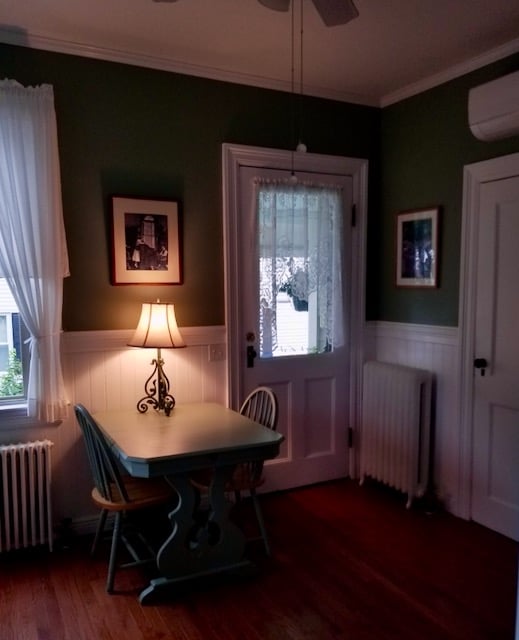
The updated Peirce Street kitchen c.2023. Submitted photo
Three years ago, during the pandemic, it was time to update and renovate the kitchen and pantries, largely unchanged since its 1938 makeover. The tile walls came down, replaced with wainscoting on the walls, and the linoleum floors were pulled up, replaced with hardwood. The yellow kitchen sink was refinished in white, to match the wainscoting on the walls. New appliances, of course, were installed, along with freshened paint and moldings, in the spirit of the 1894 original.
But the one thing that has stayed the same: The Kitchen Table, sturdy and ready to welcome more meals, visitors and memorable gatherings for decades to come. And a special spot for writing correspondence and retrospective thoughts, as attested here.
Even as our kitchen table remains in place, a practical and sentimental relic of times past, there are many folks still in our midst, who are living witnesses to those days. So consider inviting them to tell of those times, perhaps over a cup of tea, seated at a vintage kitchen table. Marie Benson Tingley, keeper of this homestead, hostess to countless friends and family, and scrapbooker/correspondent extraordinaire, would surely approve.
Laura Sullivan lives in East Greenwich and writes occasionally for EG News.

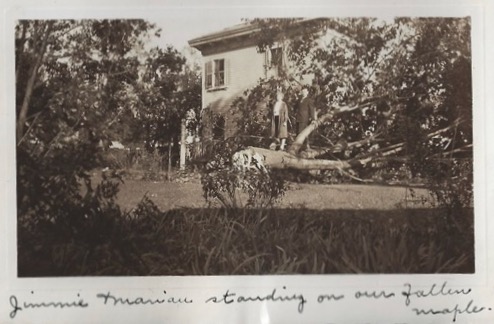


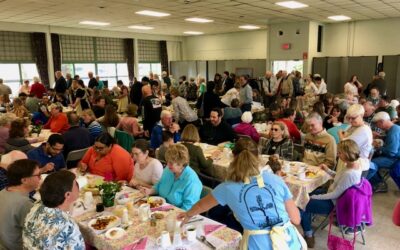

 Subscribe
Subscribe
Are there any pictures of the houses on King Street during the ’38 hurricane?
Hi Joe,
I don’t have any pictures, but you may want to check with the East Greenwich Historic Preservation Society, which may have some archived images, along with the RI Historical Society, and the Providence Journal.
…and I’m sure we’d enjoy hearing of your own, or your family’s, connection to the Hurricane, and King Street.